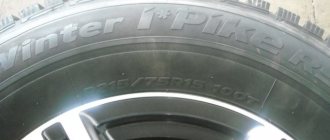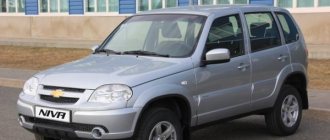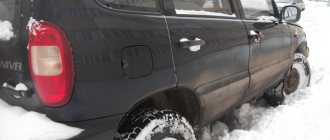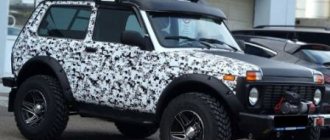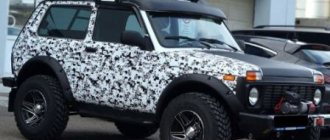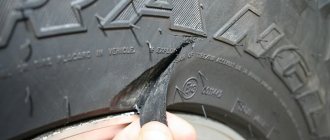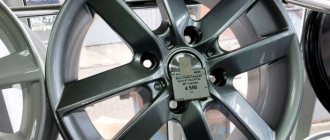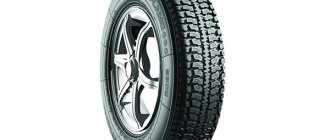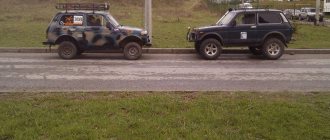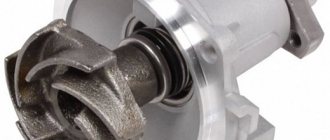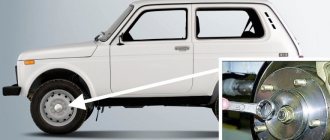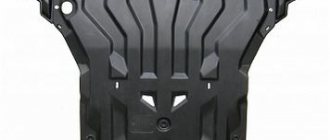As you drive, the tire tread gradually wears out. Under normal conditions, Chevrolet Niva tires can withstand a mileage of 40-50 thousand kilometers. After this, the tread height decreases. As a result of wear:
- braking distance increases;
- the car loses stability when cornering;
- When driving on a wet road, the effect of aquaplaning occurs.
Further wear causes the tire to lose strength and may burst when driving. Therefore, you need to change your tires in a timely manner and install tires that suit the weather conditions.
Rating of the best all-season tires for Niva Chevrolet
This type of rubber is distinguished by its universal rubber compound composition.
It withstands warm weather and does not harden in cold weather.
Bridgestone Dueler A/T 001
Description of the tire. A universal model of tires for off-road vehicles from a Japanese company.
It features an original pattern design and high strength characteristics.
The location of the contact blocks on the tread is simulated by a computer program.
It allows the model to reduce noise levels and improve performance characteristics.
The rubber behaves equally well on off-road and asphalt surfaces.
When producing rubber material, a special combination of silica and polymer additives is used.
This improves the strength of the compound, making it resistant to punctures and mechanical contacts.
The basis of the drainage system are two powerful drainage channels. They are located near the shoulder areas and help remove dirt, water, and snow from the contact area.
The contact spots of the outer blocks that follow them act as lugs. They help the tire pass difficult sections of the road and are responsible for stability when maneuvering.
- Fairly quiet running.
- Durable sidewall.
- Acceptable cross-country ability.
- Original tire pattern design.
- When driving off-road, the tread does not become washed out.
- Normal handling.
MAXXIS Bravo AT-771
Description of the tire. These tires from the Taiwanese manufacturer are suitable for off-road vehicles, such as the Niva Chevrolet SUV.
The year-round use of this tire is due to the tread pattern with pronounced contact spots.
A high level of drainage is ensured by an effective drainage system.
Its main elements are four deep channels located in the central part of the tread.
They are connected to multidirectional grooves, which also help remove dirt, slush, and water from under the wheel.
Numerous sipes covering the entire width of the tread provide a tenacious grip on the road surface. This improves road grip and shortens braking distance.
As befits all-terrain tires, it has a reinforced carcass that improves its strength parameters. It is based on twisted nylon threads.
- Affordable tire prices.
- Easy balancing.
- Low noise level for off-road tires.
- Fast self-cleaning.
The tires perform well on asphalt and dry primers. On “steep” off-road conditions, their owners note, they will be ineffective.
Rating of the best summer tires for Chevrolet Niva
The tire models included in the rating are distinguished by their versatility.
They can be used to travel along the roads of a metropolis, travel to the village or to the country.
These tires maintain their performance on asphalt and dirt tracks.
Nokian Tires Nordman SX2
Description of the tire. The peculiarity of this model from the Finnish manufacturer is its low noise level, resistance to aquaplaning, and stable control when driving at speed.
The drainage channels located in the center are equipped with miniature round-shaped recesses.
Thanks to them, the air flow generated during movement reduces the speed of movement and, accordingly, produces less noise.
The original shape of the walls of numerous grooves eliminates the displacement of contact spots when in contact with the road, thereby improving the directional stability of the car.
Wide slots in the shoulder areas of a complex configuration help quickly remove dirt and water from the contact area between the wheel and the track.
Large areas of the outer blocks play the role of lugs and improve the vehicle's cross-country ability.
- Resistant to aquaplaning.
- Confident movement on average off-road conditions.
- Excellent interaction with the steering wheel.
- Not afraid of ruts.
- Low noise tires.
- Excellent grip.
- Economical tires - reduced fuel consumption.
To reduce wear, experienced car enthusiasts recommend slightly overinflating the tires by about 0.3 atm. In general, users are satisfied with this model.
Viatti Bosco A/T
Description of the tire. A tire from domestic manufacturers for SUVs, i.e. it is quite suitable for installation on a Niva Chevrolet.
The rubber mixture used in the production of the model is made using a unique technology.
It can change its density depending on temperature, maintaining performance in hot and cold weather.
The original inclined shape of the protrusions of the walls of the longitudinal channels helps reduce noise when the car is moving.
The tread with an asymmetrical pattern is divided into five blocks, each of which has its own purpose. Central - responsible for directional stability.
Wide outer zones help to hold the car when changing lanes, turning, and also contribute to good handling of the Niva Chevrolet.
- Excellent driving performance when traveling around the city.
- Good driving performance – off-road.
- Resistant to shock loads.
- Handling: 5+.
- Good grip.
- Safe braking.
As the owners say, this model is a great option for a reasonable price.
Standard 16" tire options
The standard tire size for Niva is quite unique - 18575R16 - narrow and tall tires of 16 diameter. Not many manufacturers produce tires of this size, and even fewer produce narrow and tall winter tires of 16 diameter.
Which winter tires to prefer for the Niva - studded or not - each car owner decides for himself (on our website there is an article to help: Velcro or studs).
Since the Niva is primarily an SUV, studded tires are most often selected for it.
Among studded tires, one of the most popular are Voltyre VLI-5 and VLI-10. Tires of this particular brand are installed at the factory, so this option is the most inexpensive. But not the most optimal, since the driving characteristics of these tires leave much to be desired.
For standard sizes you can also find winter studded tires of such models as:
- Amtel K182A (Seven Hills)
- Cordiant Business
- Gislaved NordFrost Van
- Nokian Nordman C
- Nokian Hakkapeliita C Cargo
- Michelin Agilis X-ice North
- Good Year Cargo Ultra Grip
Among the non-studded options for the standard Niva size you can find tires of the following models:
- KShZ K182A (Amtel Seven Hills)
- Kama Euro LCV
- Rosava LTW
- Viatti Vettore Brina
- Belshina Bravado
- Tigar Cargo Speed
- Yokohama W.Drive
- Hankook Winter Ipike
- Continental VanContact
- Nokian WRC3
However, it is worth mentioning that except for the domestic Amtel, Cordiant and Kama, as well as the Ukrainian Rosava and Belarusian Belshina, all other tires will be quite expensive, so most Niva owners will not consider them as winter tires for their car. Because instead of these expensive 16-radius tires, you can install 15-radius tires, which will cost significantly less.
Rating of the best winter non-studded tires for Niva Chevrolet
Velcro tires provide confident grip on the winter road due to pronounced contact blocks and special rubber production technologies for the cold season.
Viatti Bosco S/T V-526
Description of the tire. The tread pattern of these Velcro tires is equipped with a large number of multi-directional sipes.
With their sharp edges they cling to the winter road, providing high-quality grip.
The curved shape of the blocks also enhances the grip properties of the rubber.
The curved grooves of the various blocks are interconnected, which allows you to quickly throw out slurry from the contact area.
Polymer additives introduced into the rubber mixture make it possible to maintain performance characteristics at low temperatures.
Hankook Tire DynaPro i*cept RW08
Description of the tire. This model of studless winter tires with a symmetrical directional pattern has good grip properties.
For its production, a high silicon content is used, which improves such characteristics.
The middle block helps the car maintain directional stability. Shoulder areas of increased rigidity with deep grooves hold the Niva Chevrolet during cornering.
The grooves of the blocks, extending onto the sides of the tire, remove water and snow slurry from under the contact zone of the tire and the track.
A well-developed network of drainage system channels allows the driver not to be afraid of hydroplaning.
- Confidently “rows” through the snow, slushy snow.
- Excellent grip on the road surface.
- Predictable control.
- He behaves normally on the ice.
- No hydroplaning.
Car enthusiasts note that this model is a suitable option for the price/quality ratio.
Reviews of the best brands: popular options for summer and winter tires
Tires for a car are the most important structural unit necessary for the full functioning of the vehicle - you should not skimp on the quality of these components.
Read more: How to choose tires for rims
When choosing new tires, you should follow the pricing policy of dealer products - a high-quality tire will cost around +/- 15% of this cost, which is explained by the markup for the brand and the cost of transporting the product to the point of sale. The obviously low price of analogues of original components is a discrepancy between the rubber and the declared technical characteristics or an improper storage method, which leads to a deterioration in the quality of the products.
In order for the tires to last longer and ensure uniform adhesion to the road surface, it is recommended to calibrate the slopes when changing a set of tires or every six months. Balancing the ramps consists of diagnosing the trajectory of the wheel and identifying deviated vectors relative to the radius of movement, as well as leveling the ramp by installing weights under the cord of the product.
Comparison table of the most popular tires for Chevrolet Cruze:
| Name/brand | Standard size | Type of rubber | Load index, kg | Speed index, km/h | Approximate cost, rub. per piece |
| Premiorri Solazo | 205/60 R16 92V | summer | 630 | 240 | 2100 |
| Rosava Itegro | 205/60 R16 92V | summer | 640 | 230 | 2000 |
| Belshina ArtMotion | 205/60 R16 92H | summer | 630 | 210 | 2300 |
| Premiorri Via Maggiore | 205/60 R16 92T | winter | 630 | 190 | 2100 |
| Rosava Snowgard | 205/60 R16 92T (studded) | winter | 630 | 190 | 2500 |
| Achilles Winter 101 | 205/60 R16 96H XL | winter | 710 | 210 | 2800 |
| Triangle PL 01 | 205/60 R16 96R | winter | 710 | 170 | 3000 |
| Kleber Quadraxer 2 | 205/60 R16 96H | all-season | 710 | 210 | 4500 |
| Vredestein Quatrac 5 | 205/60 R16 96H | all-season | 710 | 210 | 5000 |
| Michelin Cross Climate | 205/60 R16 96V XL | all-season | 710 | 240 | 6000 |
Rating of the best winter studded tires for Niva Chevrolet
Icy roads are a common occurrence in our country. Studded tires will help Niva Chevrolet owners move safely on such roads.
We present the models that Russian drivers liked.
Viatti Bosco Nordico V-523
Description of the tire. This tire ensures confident movement on any type of road in winter.
The presence of wide and deep channels allows you to avoid slipping on a wet snowy road.
Their dimensions make it possible to quickly remove snow trapped in the slots and improve traction properties.
The top layer of tires is made of an elastic rubber compound that does not harden at low temperatures.
The model is studded across the entire tread width, which allows you to confidently “hold” the road when changing lanes and maneuvers.
The middle stiffener, together with the extreme zones of increased density, have a wide contact area.
This allows you to keep directional stability under control and ensure safety when cornering.
- Reliable grip on icy roads and snowy roads.
- Good maneuverability.
- Strong sides.
- Excellent directional stability.
- Good handling, even at high speed.
Despite the remark, car enthusiasts like the tires and recommend them for purchase.
Dunlop Grandtrek Ice02
Description of the tire. The most popular model of winter tires for off-road vehicles from the British company.
Its symmetrical directional pattern ensures confident movement on winter roads with any surface.
The contact spots of the shoulder areas do not deform under load thanks to the installed jumpers between them, which significantly improves traction.
The original structure of the Miura-Ori Z-shaped sipes allows the load to be evenly distributed over the entire tread area, thereby reducing tire wear.
When they come into contact with the road surface, they open up, increasing the traction area and enhancing the quality of braking.
An effective drainage system includes wide multidirectional grooves that ensure timely removal of snow, slurry, and water from under the tire.
The high quality material of the studs makes their service life long.
- Excellent handling on asphalt, ice and snow.
- Excellent maneuverability.
- Firmly placed spikes.
- Prevents skidding.
- High quality braking.
Users are unanimously positive about this model of studded tires. The noise that some drivers complain about disappears after running in (400 - 600 km).
How to choose the right winter tires for Chevrolet Niva
With so many tires to choose from, it's becoming increasingly difficult to choose the right tires. Winter tires for a car are a rather expensive purchase, and their choice must be taken seriously.
Before purchasing winter tires, you need to pay attention to:
DOT marking
- Size. In order to choose the most suitable tire size, the best option would be to look at the tires that are currently in use. The most popular winter tires on the Chevrolet Niva have parameters of 215/65 R16, installed on wheels with a diameter of 16 inches, and sometimes 15 inches.
- Speed index. The lower it is, the higher the tire's permeability on very snowy roads.
- Wear indicator. This parameter indicates how long the bus will be operational. The larger it is, the longer the rubber will last.
- DOT marking. Its existence indicates that such tires do not contradict safety standards.
- Pressure index. If the tire pressure is incorrectly set, the tires will not function properly and will not be able to cope with their task.
- Balancing. The imbalance causes the car to sway.
Important! Winter tires for Niva Chevrolet must be selected extremely carefully, because this SUV has the highest requirements.
General tire parameters
The industry produces different types of tires, which differ in size, tread pattern and other parameters. They can be identified by the markings that are applied to the side surface of the tires.
Size
Manufacturers indicate three parameters that determine the tire size:
- Inner diameter in inches.
- Tire width.
- The ratio of the height of the product to the width in percentage (rubber profile).
These parameters are indicated in the following order: width, profile, diameter. For example, the marking 185/65 R15 means the following:
- Tire width is 185 millimeters.
- The profile height is 120 mm (65% of 185 mm).
- The landing (inner) diameter is 15 inches.
Help: As standard, the Chevrolet Niva is equipped with tires with a seat diameter of 15/16 inches, a width of 205-215 millimeters and a profile of 65-75%.
The size of tires affects their performance properties. The area of the contact patch with the road surface is proportional to the width of the rubber. The larger it is, the better the grip and the shorter the braking distance.
Also, wide wheels reduce the specific pressure on the ground, thereby increasing off-road capability. However, too wide tire width also has disadvantages:
- The wider the tires, the higher the rolling resistance. This worsens dynamics and increases fuel consumption.
- A large contact patch increases the likelihood of aquaplaning. It is better to drive through puddles on the asphalt on narrow tires.
- Geometric dimensions determine the weight of the rubber. As the weight of the wheels increases, the load on the suspension increases.
- Wide tires are more expensive than their narrow counterparts.
- Less ground pressure worsens vehicle handling on country roads.
Therefore, you should not chase the widest tires. It makes sense to buy it only if you constantly use the car in off-road conditions.
Depending on the ratio of the tire height to its width, rubber is divided into three categories:
- Low profile (55% or less).
- High profile (60-75%).
- Full profile (from 80%).
The designers of the Chevy Niva have provided for the possibility of installing high-profile tires. Full-profile tires can be installed on a car only after such alterations as “lifting” the suspension.
This operation increases ground clearance and space between the fender liners and wheels. Installing low-profile tires while retaining the original wheels reduces the ground clearance to a level below the permissible level.
As a result, the likelihood of damage to vehicle components increases.
Low-profile tires along with large-diameter wheels can be found on tuned Nivas. But it is better to use such specimens only on a good road.
Types of tread
The design on the side in contact with the road has no aesthetic value at all. The shape and depth of the tread determine the performance characteristics of the tires. The installation features and the interchangeability of rubber depend on this parameter.
There are three types of drawings:
Symmetrical omnidirectional
Tires with this tread pattern are most common in the budget segment of small tires. These wheels are designed for driving on highways and city roads. The convenience of a non-directional tread is that its characteristics do not depend on the direction of rotation of the wheel. Therefore, if necessary, tires can be freely swapped.
Symmetrical directional
Rubber with such a tread is more expensive, but it has better grip on the road surface. In wet weather, the directional pattern allows water to be drained away from the contact patch faster. However, such tires are noticeably more expensive. Besides the price, they have another drawback.
Tires with directional tread should rotate in the direction indicated by the arrows on the sidewalls. Therefore, you can’t just swap left and right wheels. This can only be done by rearranging the tires on the rims. When the wheels rotate in the “wrong” direction, water drainage from the contact patch and traction with the road deteriorate.
Asymmetric
This pattern provides tires with better grip on wet roads and dry asphalt. Therefore, such tires provide good cross-country ability and high vehicle safety. The outer and inner sides of the tread have different patterns and are marked when hitting a pothole.
Load Index
This characteristic shows how much weight the tire can support. “Factory” tires on the Chevrolet Niva, depending on the profile width, have a load index of 86-98. This means that the wheel can withstand a weight of 530-750 kilograms.
When a car moves, especially on a bad road, the wheels, in addition to the static mass of the car, are subject to dynamic loads. Therefore, if you are going to transport cargo with your car and operate it in difficult road conditions, you should not install tires with a load index below 96 (710 kilograms).
Tire carcass
Previously, tire manufacturers produced two types of car tires: bias-ply and radial.
However, today such a division is not relevant. All passenger car tires on the market have a radial frame. This design is designated by the letter R.
Tires for trucks and minivans are made with reinforced walls that can withstand harsh operating conditions.
Their markings contain the letters C (cargo) or LT (light truck), which means “cargo” or “light truck.” Such tires have a significantly greater safety margin.
What size winter tires should I use?
Winter wheels must not only cope with difficult conditions of icy or snowy roads, but also be suitable for the standard size of the car. The design of the Chevrolet Niva allows you to install tires with diameters of 15 or 16 inches. At the same time, such standard sizes as 195/70, 205/75, 205/70 or 185/75 are suitable without lifting.
R15
Despite the fact that the manufacturer in its recommendations gives preference to 16-inch wheels, it still allows for the possibility of installing products designed for R15 wheels, which can be found more often on the market. The most suitable sizes with this diameter are 195/70/R15, 205/75/R15 and 205/70/R15. In them, manufacturers offer a fairly large number of models to choose from at not very high prices.
It is worth highlighting the following products with spikes:
- Amtel NordMaster;
- Viatti Vettore Inverno;
- Kumho WinterCraft ice;
- Cordiant SnowCross.
- Nexen Winguard WinSpike;
- Matador MP 30;
- Jislevd NordFrost 100;
- Yokohama F700Z;
- Yokohama IceGuard IG35;
Tires with treads without studs, designed for winter roads, are also presented:
- Toyo Observe Gsi-5;
- Tunga Nordway;
- Viatti Vettore Brina;
- Kumho KW 7400;
- Nexen Winguard ice;
- Yokohama IceGuard IG 30;
- Sava Eskimo Ice;
- Nokian Nordman RS;
- Dunlop Graspic DS3.
In addition to these models from the budget and mid-price segments, manufacturers are able to offer car owners a fairly large list of specialized wheels at a more expensive price.
The poorest selection of tires is for size 205/75/R15, which, at the same time, is indicated by the manufacturer as a standard option. In fact, the domestic brand Cordiant is a monopolist in this segment. Its wheels are inexpensive, but still many Niva owners prefer to replace them with something else.
R16
Exactly 16 inches is the standard radius or, more precisely, diameter for Chevrolet Niva tires. The manufacturer installs the standard size 185/75/R16 on the car. The problem with such tires is that they are both narrow and high, so companies do not often undertake the production of such models, especially in the winter version.
Most wheels for the cold season with these sizes are made with studs. They are also the most popular among SUV owners in general. The stock option for the Chevrolet Niva is Voltyre VLI-5 and VLI-10 - they are inexpensive and easily accessible. But they do not have the best driving characteristics. Because of the latter, most car owners strive to replace them with something else at the first opportunity.
Among the popular studded substitutes, there are the following models that fully comply with the instructions of the Niva manufacturer:
- Amtel K182A Seven Hills;
- Nordman Nordman 4;
- Cordiant Business;
- Good Year Cargo Ultra Grip;
- Jisleivd NordFrost Van;
- Michelin Agilis X-ice North;
- Nokian Hakkapeliita.
Since studded tires are not always needed, models without studs on the tread are also available on the market:
- Rosava LTW;
- Amtel Seven Hills;
- Viatti Vettore Brina;
- Nokian WRC3;
- BelShina Bravado;
- Kama Euro 519;
- Hankook Winter Ipike;
- Tigar Cargo Speed;
- Yokohama W.Drive;
- Continental VanContact.
Seasonality
According to this criterion, car tires are divided into three types:
Summer
Tires are made of hard rubber that does not soften at high temperatures.
They wear out more slowly on hot asphalt. This guarantees a long service life and short braking distances. The tread pattern of summer tires removes water well from the contact patch and prevents aquaplaning.
However, at low temperatures, the rubber of summer tires loses its elasticity. At temperatures below 5 degrees Celsius, the adhesion coefficient of such tires decreases sharply. In winter, the braking distance of a car with summer tires increases significantly.
Important! Tires that have lost their elasticity glide easily even on clean, dry asphalt. Therefore, it is necessary to install winter tires for the winter.
Winter
The rubber of these tires remains elastic at low temperatures, which ensures reliable grip on asphalt. In order to hold the car on snow or ice, the tread of winter tires has many sipes, the edges of which “cling” to the road.
However, such tires soften greatly on hot asphalt and are not suitable for use in the heat. Separately, it is worth noting the winter studded tires.
They are made of harder rubber than winter non-studded ones. Spikes provide good traction in snow and mud. However, studded tires have a longer braking distance on asphalt and ice. Therefore, in urban conditions it is better to use tires without studs.
All-season
These tires are a cross between summer and winter. Accordingly, they wear out faster than summer tires on hot asphalt. And when used on snow, ice or even winter asphalt, all-season tires do not have a good grip coefficient. Its only advantage in summer is good cross-country ability in mud or sand. Therefore, such tires are not so rare on Niva.
Recommend all-season
Recommend all-season
Post by Sash » 08 Feb 2012, 20:48
Re: Recommend all-season
Post by rum » 08 Feb 2012, 21:33
Re: Recommend all-season
Post by Warlock » 08 Feb 2012, 22:04
Re: Recommend all-season
Post by Vladimir55 » 08 Feb 2012, 22:26
Re: Recommend all-season
Post by rum » 08 Feb 2012, 22:35
Re: Recommend all-season
Post by Vladimir55 » 08 Feb 2012, 23:02
Re: Recommend all-season
Post by den-rio » Sep 20, 2012, 10:53 am
Re: Recommend all-season
Post by Sunny » Sep 20, 2012, 12:07 pm
Re: Recommend all-season
Post by Sash » Sep 20, 2012, 01:44 pm
The Kama-232 is perfect for summer asphalt, and according to comparative tests (the Zarulevites carried them out, I don’t remember exactly) it performed well on both dry and wet asphalt. Of course, there is no point in sticking it into the big mud. A little off-road is hard to stomach. It’s dangerous to drive it in winter; a couple of times my dad turned around almost out of the blue, even at a low speed (about 50 km/h), it’s good that there were no oncoming traffic.
Of the Russian all-season vehicles, I only tried the Kama Fly: in the summer everything is fine on it, it rolls perfectly, it brakes well on dry asphalt, I didn’t notice any hydroplaning in heavy rain (maybe because the tires are still new and the tread is high?). In winter I drove on almost bald tires (I had old tires from the previous owners, the tread was 80 percent worn, I installed a new set in April) - if you are smart enough, then you can drive quite normally in winter, although you have to be careful in the ruts, it throws. When choosing to replace a worn-out Kama Fly with something foreign, I was sorry for the money, because... All the imported tires in the size I needed were almost twice as expensive as the Kama Fly (or I also had to buy new wheels). Something like that.
It's the end of summer, it's time to pick up winter tires for your iron horse. And for the owners of Niva and Sheviks, today I have a full review from the owner of a Chevy, who has been driving our domestic Kama 515 tires for 3 seasons.
It has a studless modification (because it is used all year round, and studs on asphalt are not comme il faut), but there are also exactly the same studs on sale. The price tag is very humane; with the rise in the dollar exchange rate, all growers will have to “put on shoes” in domestic tires, both summer and winter. At first I thought that he had something imported, it had been driving for many years, it was stable. He came up and looked - yikes, Kama. Well, I say - tell me what and how))
So, now, in fact, information on this model of Nizhnekamskshina. Available in 5 sizes, all suitable for Niva and Chevy. Most Popular:
- 215/65/R16
- 205/75/R15
The price tag is approximately 2600-2800 for these models. As we see, it’s quite humane, especially during a crisis.
The first is more often installed by car owners, the second by Chevy owners. It all depends on what kind of drives you have, as well as where you use them. The tread pattern is very “winter”, thanks to which the tire behaves normally even on loose snow, on melted snow, on crust, and on ice, of course, worse. Of the minuses, I will note first of all the “instability” of the batch, as a result of which one wheel can be balanced by 40 grams, and the second and third by 100 and 150. So when buying, choose a rounder one. And according to people’s reviews, balancing is the weak point of the 515th Kama.
In winter, my impressions are positive, especially in loose, deep snow - I constantly drive in the “park wherever I want” mode, there are always a couple of places with snowdrifts where I can park. And if everything around is busy, I turn on the low switch and eat a snowdrift. The rubber rolls very cool.
You need to drive carefully on ice; perhaps it would be better with spikes. But if you drive headlong, brake with the engine in advance, then it’s quite possible to drive in winter. The tread has winter Velcro sipes, making the tire all-season. As it turned out later, many of the breeders I know own exactly the 515th Kama, which they drive “in tail and mane” all year round.
I use the Kama 515 all year round and even with decent mileage on asphalt it sharpens very slowly. According to my estimates, there are enough thousand for 70-80 years of use for sure. Although after a year the 4 slats have worn down noticeably and in winter it will no longer be comfortable to drive.
Well, the main use in the summer is fishing and hunting trips, on dirt roads, country roads and mud. Everything suits me here, the mud performance is like that of an AT, and driving on the highway is quite comfortable. Of course, you shouldn’t get into serious mud; the tread pattern is far from the pattern of MUD slippers. But with a lowering, center blocking and a clear head you can go very far, believe me. Well, at worst, I have a fiskar, an ax and a jack)) That’s enough for me.
If we compare it with imported all-season tires for Niva, then the price tag there is already one and a half to two times higher. On average, imported tires cost about 5,000 rubles per cylinder. But here it’s only 2800 - there’s a difference. And in my opinion, the Kama 515 is quite suitable for Niva and Chevy for year-round use. If you don't drive headlong in winter. In fact, these are the optimal cheap tires for year-round use - in snow, mud and asphalt. Other domestic models have a clear bias either towards the summer or towards the winter.
Video of Niva Chevrolet on Kama 515 in loose snow
| Engine | Year | Body | Tires | Discs | Tires for tuning | Tuning wheels | Other |
| 1.7 4WD | 2002 | 2002 | Factory equipment |
Tire prices
The cost of tires depends on the manufacturer and tire size. At the same time, summer, winter and all-season tires of the same manufacturer and size are almost the same in price. Only studded tires are noticeably more expensive.
Approximate cost of 15-inch tires for Chevrolet Niva:
- Kama Flame - 3600 rub.
- Dunlop - 4300 rub.
- Hankook - 4350 rub.
- Barguzin - 3000 rub.
Tires for Shniva with a seat size of 16 inches are slightly more expensive.
To increase the ground clearance of the Chevrolet Niva, ready-made or home-made “lifting kits” are used. When lifting a car at a high altitude, even shock absorbers, springs and some other suspension parts have to be changed. Thanks to this, it will be possible to insert tires of increased height into the wheel arches. Typically, lifted Shnivy tires are fitted with tires up to 240/80 R15.
Among domestically produced SUVs, Chevrolet Niva has received a well-deserved leadership in sales. But a relatively small percentage of owners use it for its intended purpose - off-road. This car acts as an everyday vehicle. Most often it can be found in rural areas as an excellent option for dirt roads and highway driving. Not everyone decides to “knead the dirt” on a Chevrolet Niva.
What off-road tires should I put on a Chevrolet Niva?
For off-road conditions, the Chevrolet Niva is equipped with M/T tires. It is not suitable for asphalt due to high noise, poor handling and rapid wear, but it is perfect for dirt, country roads, fields, and swamps. This tire is made from special rubber and is very soft. Off-road tires maintain low pressure perfectly, and at the same time they are not damaged when colliding with rocks. M/T tires for Chevrolet Niva are most often represented by such models as I-569 Medved, Cordiant off Road, Hankook Dynapro MT RT03.
Off-road tires
Wheels and tires for Niva Chevrolet
Tires determine ground clearance, cross-country ability and, in some cases, noise. The manufacturer installs several types of tires on Niva Chevrolet. The basic L and LC trims are equipped with 15-inch radial products (R15) with sizes 205/75 and 205/70. The LE trim level can be equipped with alloy wheels with 215/65 R16 tires with off-road characteristics. The top-end GLS and GLC are also equipped with alloy wheels in size 215/65 R15. Although the manufacturer positions this type of tire as off-road, owners prefer higher-profile products for off-road use. The Niva Chevrolet wheel size is as follows:
- rim width – 6 inches;
- rim diameter – 15 inches;
- disc offset – ET-40 (distance between the disc mounting surface and the rim plane – 40 mm);
- bolt pattern - 5x39.5;
- The diameter of the hole for the hub is 98.5 mm.
When choosing tires, be sure to consider the wheel size. Some people buy all-season tires and use them only in winter and summer, others prefer to have different sets for different weather conditions, even mud tires for off-road use.
Safety can only be guaranteed by tires designed for a particular road surface. There is no such thing as universal rubber.
What tire sizes does the manufacturer recommend to install?
The choice of tires is a real problem for most Chevrolet Niva owners due to the fact that the “range of sizes” is limited. Driving for a long time on tires with inappropriate sizes leads to decreased vehicle control and emergency situations.
| Wheel disks | Tires |
| L, LG, GL 15 6Jx15 ET45 | 205/75R15 |
| GLC, LE, LE+ 16 6.5Jx16 ET44 | 205/70R15, 215/65R16 |
The abbreviation stands for as follows:
- wheel rim width;
- surface diameter;
- reach length;
- tire width;
- height in percent;
- diameter of the metal rim.
The higher the disc is installed on the car, the greater the risk of skidding and reduced control efficiency. At the same time, excessively low wheels also negatively affect ground clearance, lower ground clearance, and limit the vehicle’s maneuverability.
Choosing summer tires
To select the right tires for an SUV, you need to follow the manufacturer's recommendations and take into account the operating conditions of the vehicle.
Tread pattern
The tread on the tires is different, not for beauty. The performance characteristics depend on this parameter. There are three types of patterns:
- Symmetrical, without direction. A classic tread option, suitable for driving around the city and on the highway. This pattern is often used on inexpensive budget tires. The characteristics do not depend on the direction of movement and operating conditions. Standard option from the manufacturer.
- Symmetrical, with direction. Rubber with a similar pattern is characterized by good grip and effective removal of water from the contact patch. Excellent for high-speed driving, including in rainy and spring weather. They cannot be installed on any hub, as they have a strict direction of movement, indicated by an arrow on the cord.
- Asymmetrical. The universal pattern is equally suitable for wet weather and dry weather. It is found not only on SUVs, but also on sedans and family station wagons. This rubber has different patterns on the inside and outside. When installing, you also need to pay attention to the inside/outside designation.
Each of the listed tread patterns has both advantages and disadvantages.
Speed index
An important parameter for choosing tires for the Chevrolet Niva. Markings in the form of Latin letters indicate the maximum speed that can be achieved on these tires.
Maximum speed, km/h
For civilian versions of tires, the maximum speed reaches 300 km/h. It’s not worth considering all of them, since for the Chevrolet Niva, a speed of 140 km/h is already the maximum - its power unit will not be able to handle more. Tires with a high index are much more expensive, and there is no point in overpaying for it.
Load Index
The parameter determines the load that the tire can withstand when driving at maximum speed. This is the weight of a car with passengers and cargo allowed on one wheel. The index ranges from 70 to 120, which corresponds to a load from 335 to 1400 kg. If you plan to transport passengers and heavy loads, then it is better to take tires with a high index. But buying tires with an index that does not correspond to the maximum load allowed by the manufacturer is also not worth it.
Choosing the right tires
When choosing mud tires, the owner should pay attention to the following type designation parameters:
- Tires marked with the letters N/T are designed to overcome greater loads than standard tires, but for primary use on public roads. Such tires will cope with off-road conditions, but their capabilities will not be enough to overcome extreme obstacles;
- The A/T marking means the presence of excellent parameters for overcoming “average” off-road conditions. Suitable for use on regular roads, while giving the vehicle increased stability;
- The M/T designation means that this type is intended for rough off-road use and is not well suited for use on normal surfaces. Also, this tire has the highest off-road grip properties, but a set from a good manufacturer has the highest cost (the amount for 4 tires can reach up to 35,000 rubles);
Each car enthusiast independently chooses the type of tire according to the conditions of use.
Mud tires are fully compatible with stock wheels with a diameter of 15 inches (radius). This is the size recommended by the manufacturer.
If you install wheels with a larger diameter, the wheels may catch on body elements when turning, and suspension parts are subject to greater wear and rapid failure.
Also, a disadvantage when choosing large wheels is the corresponding increase in the cost of the entire set (tires + wheels) by about 20%, and given the considerable cost of mud tires, the amount is impressive. Therefore, using disks with a diameter of 15 or 16 inches is the most optimal solution.
Choosing winter tires
Owners believe that there is no need for winter tires on a Chevrolet Niva, since the car is an SUV. The reason why car enthusiasts do not want to install winter tires is simple: high financial costs. Even tires made in Russia, and with the smallest radius possible for a Niva, are expensive. It’s not enough to buy such winter tires; you’ll have to pay for tire fitting services and get an alignment done in order to preserve the product longer. The amount turns out to be quite large. An SUV needs winter tires, and there are a number of reasons for this:
- A four-wheel drive car brakes in exactly the same way as a single-wheel drive car, the only difference is in the acceleration speed.
- On a slippery road, a car with all-wheel drive and increased ground clearance is much less stable, as the aerodynamic characteristics leave much to be desired.
- The SUV performs well off-road, and not in icy conditions.
- Any SUV is quite heavy compared to passenger cars, which means it is more inert. No matter what type of tire is installed, the braking distance will still be longer due to the weight.
The only thing that the Chevrolet Niva can boast of is its high cross-country ability in loose snow. In all other cases, the driver must exercise great caution. This means that you cannot neglect winter tires. For an SUV, this type of tire is no less important than for cars of another class. When choosing winter tires, follow these rules:
- Classic winter tires are the choice of calm and careful drivers.
- You need to choose winter tires according to the climate. If the winter is mild and there is virtually no snow, then it is better to consider all-season tires.
- You cannot change to winter tires on only one axle.
- All tires must be of the same specifications and from the same manufacturer, otherwise handling problems may occur.
- Depending on the driving style, a tread pattern with the corresponding speed index is selected.
If most of the driving in winter is carried out on icy road surfaces, then in this case you cannot do without studs. This option involves a quiet ride, as traction decreases as speed increases.
Tires for urban conditions
It is neither necessary nor possible to turn a Chevrolet Niva into a fast supercar, so even those who drive a car in the city still prefer to endow it with off-road qualities. Of all the classes of tires, the ones marked A/T (All Terrain - for any terrain) look advantageous here. They have greater wear resistance and lower noise levels.
Maxxis AT-771 tires for Chevrolet Niva are suitable in two variations: 225/70 R15 and 225/75 R16. Wheels of a larger radius are installed on a lifted Niva. This model is considered universal, as it is suitable for the off-season. High cross-country ability on ice is not observed, but for loose snow and slush it is an excellent option. At the same time, the wheels are well balanced, the car turns obediently, and the tires are wear-resistant.
The BFGoodrich AT model was called “Worms” for its original tread. We are interested in the sizes 215/75R15 and 235/75 R15. Wide tires - for a raised Niva. The so-called worms drain water perfectly. The car is practically not subject to hydroplaning. An excellent option for the highway can also be used in light frosts. But when winter comes, it’s better to “change your shoes.”
Very quiet and soft tires that are suitable for covering long distances on the highway - Yokohama Geolandar A/T. Here fans of classics (215/65 R16) and deep tuning (235/70 R15) will find suitable options. The protector has a high degree of self-cleaning. It is absolutely unsuitable for use in winter, but performs well in mud and sandy soils.
As for winter tires, we recommend paying attention to the Nokian Nordman 7 SUV Hankook I* Pike RW11
Selection of all-season tires
All-season tires differ from others in their tread. The whole secret is that the inner side of such a tire is used for driving on loose snow, and the outer side is used to drain water from the tire contact patch to ensure better traction. When choosing, special attention should be paid to the composition of all-season tires installed on the Chevrolet Niva.
Hard tires are suitable for summer use, reducing wear. The soft one performs better in winter for traveling on snowy and icy roads. Rubber with medium hardness at a medium level will cope with its task at any time of the year. The composition of all-season tires is selected in such a way that they do not harden in cold weather and do not blur in summer. With all this, it is not subject to rapid wear when driving on a dry road and is relatively safe when traveling on snow or ice.
When choosing all-season tires, it’s easy to navigate if you know the main markings on the sides of the rubber:
The last two designations are used by manufacturers for summer tires.
According to various tests that are regularly carried out by authoritative publications, the same thing is confirmed every year: a high-quality all-season tire cannot be cheap. All-season tires have a number of significant disadvantages:
- high noise level;
- increased fuel consumption;
- reduction in dynamic characteristics;
- increased wear.
These tires can be used in the following situations:
- mild winter with positive temperatures;
- limited budget;
- there is no space to store two sets of tires;
- desire to save money on tire fitting;
- the off-season, when it’s too early to install a summer one, but it’s a pity to expose the winter one to wear and tear.
Winter tires are always unbeatable on icy roads. All-season tires show the following results: compared to winter ones, they cope with their task worse by 30-40%, studded ones show a better result by 90%. The same disappointing results on loose snow - up to 85% worse.
Basic equipment
In the basic configuration, the Chevrolet Niva is equipped with tires with parameters 185/75 R16 92Q 95T and 175/80 R16.
This option has a number of disadvantages:
- At speeds above 60 km/h the noise increases.
- Loss of elasticity in the cold.
- Deterioration in handling on dry roads.
This is interesting: What is disk ejection?
Chevrolet Niva elevator
When a person buys a Chevrolet Niva, there is no talk of extreme off-road driving. This car is mainly used for trips outside the city or in rural areas where good roads are rare. Although the Chevrolet Niva is classified as an SUV in terms of its characteristics, it is significantly inferior to its counterparts from Europe, America and Asia in almost all relevant parameters.
For this reason, car owners who do not have the funds to purchase and maintain full-fledged foreign-made SUVs, but who prefer active recreation, are thinking about lifting their car. This is a type of tuning when the vehicle's ground clearance is increased. Often such work is carried out in private garages with your own hands.
If you approach this issue wisely, the Niva can turn into a solid SUV that shows excellent results in extreme off-road trips. Lifting is not limited to any one operation. This is a series of measures to make major changes to the design of the car. Lifting allows you to install wheels of a much larger diameter on a vehicle than those recommended by the manufacturer. Basically, such projects can be found as experiments on “passenger cars”. Although an all-wheel drive SUV is much more suitable for these purposes.
Standard 16" tire options
The standard tire size for Niva is quite unique - 185\75\R16 - narrow and tall tires of 16 diameter. Not many manufacturers produce tires of this size, and even fewer produce narrow and tall winter tires of 16 diameter.
Which winter tires to prefer for the Niva - studded or not - each car owner decides for himself (on our website there is an article to help: Velcro or studs).
Since the Niva is primarily an SUV, studded tires are most often selected for it.
Among studded tires, one of the most popular are Voltyre VLI-5 and VLI-10. Tires of this particular brand are installed at the factory, so this option is the most inexpensive. But not the most optimal, since the driving characteristics of these tires leave much to be desired.
For standard sizes you can also find winter studded tires of such models as:
- Amtel K182A (Seven Hills)
- Cordiant Business
- Gislaved NordFrost Van
- Nokian Nordman C
- Nokian Hakkapeliita C Cargo
- Michelin Agilis X-ice North
- Good Year Cargo Ultra Grip
Among the non-studded options for the standard Niva size you can find tires of the following models:
- KShZ K182A (Amtel Seven Hills)
- Kama Euro LCV
- Rosava LTW
- Viatti Vettore Brina
- Belshina Bravado
- Tigar Cargo Speed
- Yokohama W.Drive
- Hankook Winter Ipike
- Continental VanContact
- Nokian WRC3
However, it is worth mentioning that except for the domestic Amtel, Cordiant and Kama, as well as the Ukrainian Rosava and Belarusian Belshina, all other tires will be quite expensive, so most Niva owners will not consider them as winter tires for their car. Because instead of these expensive 16-radius tires, you can install 15-radius tires, which will cost significantly less.
